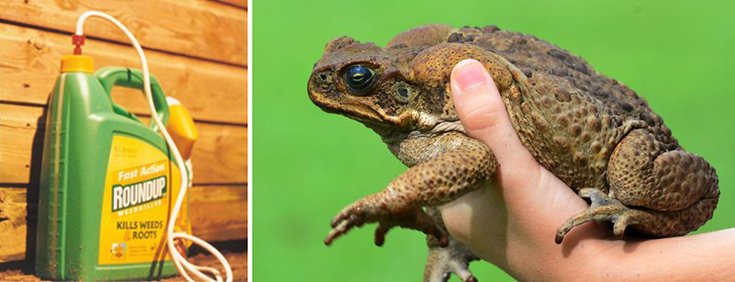Is Glyphosate Making These Australian Toads more Deadly?

Scientists in Hungary say toad tadpoles that have been exposed to the herbicide glyphosate (also known as Glyphogan in Australia) may produce considerably more of the toxic chemicals the toads use to ward off predators. The findings are especially relevant to Australia’s cane toad population. [1]
The fear is that feral cane toads in Australia could become even more toxic due to a combination of environment and the amount of pollutants and chemicals the amphibians come into contact with.
Study author Veronika Bokony said:
“Our results indicate that pesticide pollution might exacerbate the problem of invasive toxic species. For example, in Australia, the survival of native tadpoles is reduced by poisoning from ingestion of toxic cane toad eggs, and predators suffer drastic mortality due to ingesting or mouthing cane toads.”
Read: More Wildlife Fish are Experiencing “Intersex” – What Could be Causing This?
The tadpoles the researchers studied were found to have higher levels of the toxic chemical bufadienolide as adults. Bufadienolide is stored in glands in the toads’ shoulders, and it is delivered to predators via poisonous blasts. [2]
The increased toxicity makes the cane toads a threat to the native ecosystem and other organisms. Bokony said:
“Pesticide pollution might exacerbate the problem of invasive toxic species.”
The toxins are also dangerous for pets. Large doses of cane toad toxin can be deadly for dogs and cats. Symptoms of poisoning include vomiting, difficulty breathing, foaming at the mouth, or dilated pupils.
Read: Even Legal Levels of Glyphosate Herbicide May Harm Freshwater Fish Ecosystems
Frog Safe Inc coordinator Deborah Pergolotti, who is outspoken about the risks posed by RoundUp, said the study only confirms that glyphosate is a dangerous weedkiller. [3]
“There are many reasons not to use RoundUp, which not only does damage to frogs, it does damage to the human gut. It’s a systemic chemical, which means that it will get around to a lot of things.
This chemical is taken up the whole plant, so any pollen, nectar, flowers, or fruit will have the chemical in those things.”
The findings are published in The Royal Society.
Sources:
[2] The Courier Mail
[3] The Cairns Post
